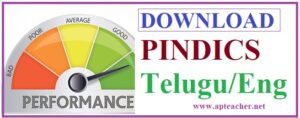PINDICS Assess the Performance Teachers as Performance Indicators
PINDICS Google Form to be filled by all teachers of AP Click Here
PINDICS : Performance Indicators is the complete version of PINDICS. PINDICS are used to evaluate instructors’ performance in the classroom. PINDICS is a collection of forms for evaluating Performance Standards (PS), Performance Indicators, and Special Standards. Teachers’ tardiness in completing their chores and responsibilities can have an impact on their performance standards. Under performance standards, there are some specific duties that are referred to as specific standards.
Google Form for PINDICS
PINDICS to be filled by all teachers of AP Click Here
The teachers from all government managements of Andhra Pradesh are need to fill this form on or before 31/03/2022(OFFICIAL GOOGLE FORM FROM AP SAMAGRA SHIKSHA)

Download PINDICS Telugu and English Version
- Download PINDICS form in English Version Click Here
- Download PINDICS form in Telugu Version Click Here
The PINDICS were formed in accordance with the regulations and provisions outlined in Sections 24,29 of the RTE Act of 2009, the National Curriculum Framework of 2005, and the SSA Framework of 2011. There are two sorts of assessments: self-evaluation by teachers and assessment by the concerned Headmaster or School Complex Headmaster.
Rating Points in PINDICS
PINDICS seeks to assist teachers examine their own performance, allowing them to make more consistent attempts to achieve the highest level possible. This can be used to provide positive and constructive feedback to teachers in order to help them improve their performance. The following are the rating points used to evaluate the performance of teachers.
- Not meeting the expected standard
- Approaching the expected standard
- Approached the expected standard
- Beyond the expected standard
Performance Indicators or Performance Standards(PS)
The desired expectations in the class room comes under Performance Standards. The following are the performance standards to be achieved in the class room.
- Designing Learning Experiences for Children
- Knowledge and Understanding of Subject Matter
- Strategies for Facilitating Learning
- Interpersonal Relationship
- Professional Development
- School Development
- Teacher Attendance
Guidelines to the Headmaster
The Headmaster shall carry out an assessment twice in a year. While conducting assessment Headmaster should keep following pints in his mind.
- Use teacher’s self-assessment record.
- Observe actual classroom processes .
- Have dialogue with teacher, pupils to supplement teacher’s report.
- Prepare a destructive report with teachers concerned to improve level of performance.
- Should discuss the report you observed with the concerned teacher to improve the level of performance.
- Complete teacher performance sheet and Consolidate sheet.
The Detailed Performance Indicators as follows
Designing Learning Experiences for Children:
- Text Books
- Learning Activities
- TLM
I.Knowledge and Understanding of Subject Matter
- Content Knowledge
- Subject Knowledge
- Syllabus
- Corrects, errors made by students
II.Strategies for Facilitating Learning
- Enabling learning environment and classroom management
- Learning strategies and activities
- Communication Skills
- assessment and Feedback
III.Interpersonal Relationship
- Relationship with students
- Relationship with Colleagues
- Relationship with parents and community
IV.Professional Development
- Self-study participation in in-service education programmes
- Engagement in innovation and research
V School Development
- Contributes to the organization of school activities
VI. Teacher Attendance
- Regularity and Punctuality